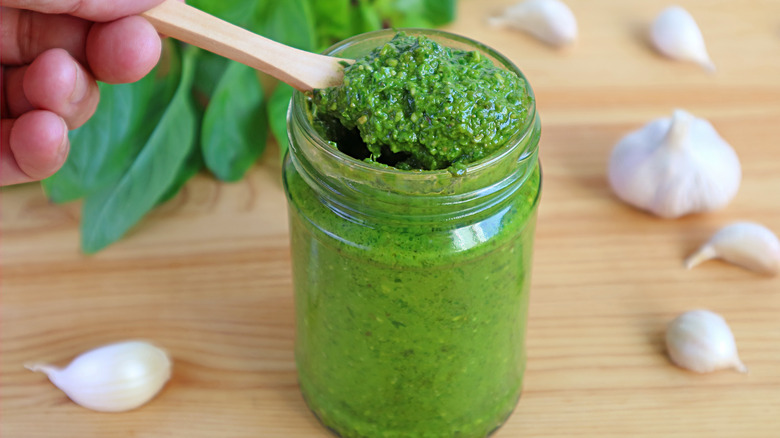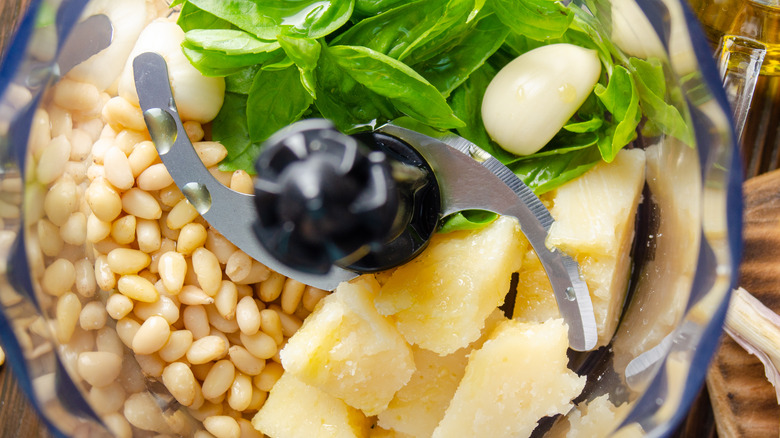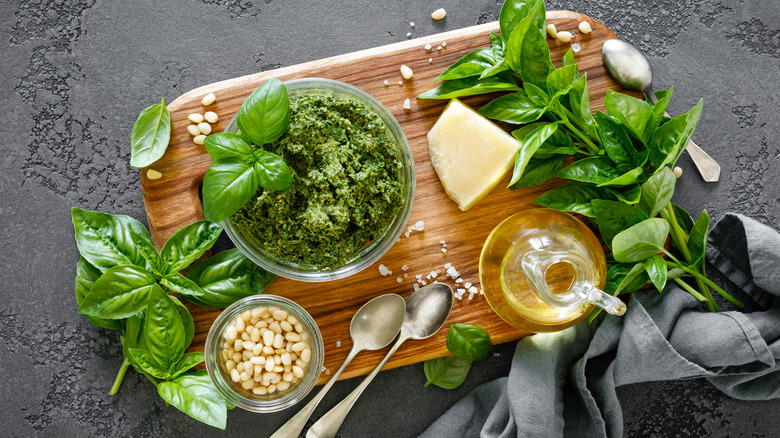The Mixing Mistake That Flattens Fresh Pesto
Foodies are pretty familiar with pesto at this point. There are lots of variations, but the most iconic pesto is definitely pesto alla Genovese. The vibrant green sauce contains pine nuts, fresh Genovese basil, garlic, extra virgin olive oil, Parmigiano-Reggiano, Pecorino Fiore Sardo, and salt. It is tempting to dump all the ingredients in a food processor and whiz it all up. It is a sauce, after all, so no harm in just blending away, right? Wrong. Your food processor is actually making your pesto less flavorful.
The word pesto comes from the Italian word pestare, which means to crush. Traditionally, pesto alla Genovese is made using a large marble mortar and wooden pestle, and the ingredients are added in a specific order. The garlic and pine nuts are crushed into a coarse paste before the basil is incorporated, adding little bits of salt at a time to help the process along. The finely, freshly grated cheese is added next and the olive oil last. The result is a creamy, thick, emulsified sauce. The varying textures are intriguing, and the basil, though broken down, remains tender.
What happens when you make pesto in the food processor?
Using a food processor pulverizes the ingredients at a rapid speed rather than gently and gradually incorporating them. Depending on the proportions of the seven ingredients, the result is either a dense, overly oily paste with beaten-up basil that loses its zip, or a dull and broken oil and herb combo with an unpleasant texture, like sand. Additionally, olive oil has the unfortunate habit of growing bitter when blended at high speeds in the food processor because the blade breaks it down into far smaller droplets than when blended manually. The bitter compounds, called polyphenols, are pushed out of the fatty acid coating that prevents them from infusing the entire liquid.
What makes pesto so delectable is that it is not perfectly uniform, yet still emulsified into a voluminous and creamy texture. It is cohesive and balanced, but you are still able to taste the flavor of each individual ingredient. This is pretty much impossible to achieve when you just dump all the ingredients into a food processor and blend.
Is it possible to take any shortcuts with pesto?
No one wants flat-tasting, savory nut butter or to waste special and expensive ingredients in a sub-par pesto. However, not everyone has the patience (or time) to make pesto by hand every time the craving strikes. Plus, investing in a large mortar and pestle both monetarily and with precious counter space is not something everyone is prepared to do.
Fortunately, there are some steps you can take to prevent pesto disappointment even while using a food processor. One way is to use the food processor judiciously to help the pesto along without taking things too far. Roughly chop the basil and pine nuts with a knife. Transfer to a food processor and just pulse to combine with the olive oil. Then, use finely grated or microplaned cheese and stir it in rather than blending.
Another tip to preserve the integrity of your pesto is to keep everything super cold. You can pop the bowl and blade of the food processor into the fridge to chill before use or shock your basil with ice or ice water to keep it crisp and bright; just make sure to dry the basil well before use. Whichever method you decide to use, select high quality ingredients. Even if you're riffing on a classic, great products make a huge difference in this simple sauce.



